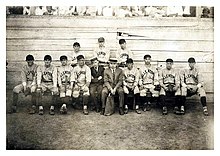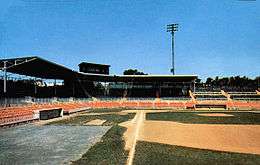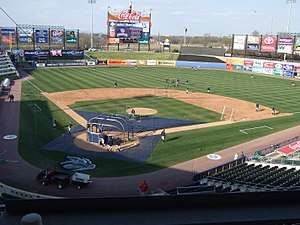History of baseball in Allentown, Pennsylvania
Allentown's association with the national pastime spans more than 125 years, from the formation of the Allentown Dukes in the late 19th century to the startup of the Lehigh Valley IronPigs in the early 21st century.
Late 19th century


Professional baseball in Allentown dates to 1884, when the Allentown Dukes completed one season in the original Eastern League. Four years later, the city fielded a Central League team, the Allentown Peanuts, which also folded after a season.[1] The 1890s brought a series of ball clubs to the city. The Allentown Colts played in the Pennsylvania State League from 1892–93. The next year, the team became Kelly's Killers, named for its player-manager, future Hall of Fame member Mike "King" Kelly. Late in the season, Kelly moved the Eastern League's Binghamton Bingoes here as the Allentown Buffalos. Kelly, the era's most flamboyant figure, died of pneumonia that fall at age 35, and the Buffalos were dissolved. In 1895, the Allentown Goobers returned to Pennsylvania State League play for one season. In 1898, yet another team was formed, re-using the name the Allentown Peanuts. The Peanuts played for three seasons in the Atlantic League, which succeeded the Pennsylvania State League in 1896. The league and the team were dissolved in 1900.[2]
Early 20th century
Over the next two decades, Allentown hosted only one professional team, a Tri-State League club which played from 1912–14. Then, in the 1920s, the name the Allentown Dukes was revived for a semi-professional team that played four seasons (1923–26) at Edgemont Field, a new field at Second and Susquehanna Streets. On September 7, 1923 the Dukes played an exhibition game with the New York Yankees at Edgemont Field. The Dukes tied the score at 7–7 in the eighth inning. In the ninth, Babe Ruth struck out with the bases loaded, and the Dukes scored in the bottom of the inning to win 8–7.[3][4] The semi-pro team led to the start of an Eastern League team under the same name in 1929.[5] League champions the next year, the team was renamed the Allentown Buffaloes in 1931. At the end of the 1932 season, the league collapsed, and the Buffaloes folded.[6]
Major League affiliation

In 1935, the city landed its first Major League farm team, when the Brooklyn Dodgers moved their Reading Brooks franchise here just six games into the season. The Allentown Brooks, like the Dukes and Buffaloes, played their home games at the Allentown Fairgrounds. The club, which was in the New York–Pennsylvania League (forerunner of today's Eastern League), finished out the 1936 season, but did not return the next year.[2]
In 1939, the Boston Braves established an Interstate League club, again using the name the Allentown Dukes, and a new park was built on the city's South Side, Fairview Field (now Earl F. Hunsicker Bicentennial Park). The team won the league championship that year. The next year, 1940, the league was upgraded from Class C to B, and the team became the Allentown Fleetwings, a St. Louis Cardinals franchise. The Philadelphia Phillies took over in 1941, playing a season as the Allentown Wings, but the franchise reverted to St. Louis the next year.[7] Renamed the Allentown Cardinals in 1944, the team played at Fairview Field until 1948, when St. Louis Cardinals owner Sam Breadon built a new park. Breadon Field, a steel and concrete stadium that seated 5,000 fans, was located just north of the city in Whitehall Township.
The demise of the Interstate League at the end of the 1952 season resulted in a one-year lull for the franchise. In 1954, the Allentown Cardinals returned as a member of the Class A Eastern League. The team won the league championship in 1955, but had its final season the next year, 1956. Midway through the 1957 season, the Syracuse Chiefs, an unaffiliated Eastern League team, moved to Allentown on July 13 to finish out the season. The Allentown Chiefs were replaced a year later by a Boston Red Sox franchise. The Allentown Red Sox played three seasons at the Whitehall ball park, which was bought by Hess's department store owner Max Hess, Jr., and renamed Max Hess Stadium. When the Red Sox left at the end of the 1960 season, the stadium closed and was demolished in 1964.[8] Today, the site is the home of the Lehigh Valley Mall, which opened in 1976. The ballfield was located near the mall's entrance from MacArthur Road.
Return of professional baseball

In 1997, professional baseball returned to the city with the startup of the Allentown Ambassadors, an independent team that played in the Northeast and Northern leagues. The club, which had its last full season in 2003, was based at Bicentennial Park.
Allentown unveiled Coca-Cola Park, a $48.4 million, 8,100-seat stadium, in 2008.[9] The stadium was constructed in east-side Allentown to serve as the home field for the Philadelphia Phillies' AAA-level Minor League baseball team, the Lehigh Valley IronPigs. The IronPigs, a member of the International League, are the first Major League-affiliated club to play in the city since 1960.[10]
During the summer of 2008, the Lehigh Valley Heritage Museum introduced an exhibit celebrating the history of baseball in Allentown and the Lehigh Valley entitled Play Ball! Baseball in America and the Lehigh Valley.[11]
References
- "League Histories". Ballpark Digest website. Archived from the original on 2007-10-22. Retrieved 2008-09-13.
- Schuler, Jeff. "Baseball has been down, but not out". Morning Call, March 30, 2008. Retrieved 2008-05-30.
- Whelan, Frank (Summer 2008). "Ask Frank". Lehigh Valley Chronicles. 2 (2): 8.
- Burian, Evan (September 3, 2013), "When 'The Babe' paid Allentown a visit", The Morning Call, retrieved March 6, 2020CS1 maint: date and year (link)
- Pawlush, George. "Duke Blazed the Trail for Allentown Baseball" (PDF). Archived from the original (PDF) on 2008-04-09. Retrieved 2008-04-01.
- "Baseball Digest: League Histories". Archived from the original on 2008-04-04. Retrieved 2008-03-23.
- "Philadelphia Phillies, 1941". Retrieved 2008-03-27.
- "Archives: Past Editorials on baseball's departure from the Lehigh Valley". Morning Call, March 30, 2008 (originally published Dec. 5, 1960). Retrieved 2008-03-30.
- "Coca-Cola Park Info, IronPigs Baseball Official Website". Archived from the original on 2008-05-09. Retrieved 2008-05-05.
- "Minor league park was a major hit". Morning Call, March 30, 2008. Retrieved 2008-05-05.
- "Baseball Exhibit To Open". Lehigh Valley Chronicles. 2 (2): 1. Summer 2008.